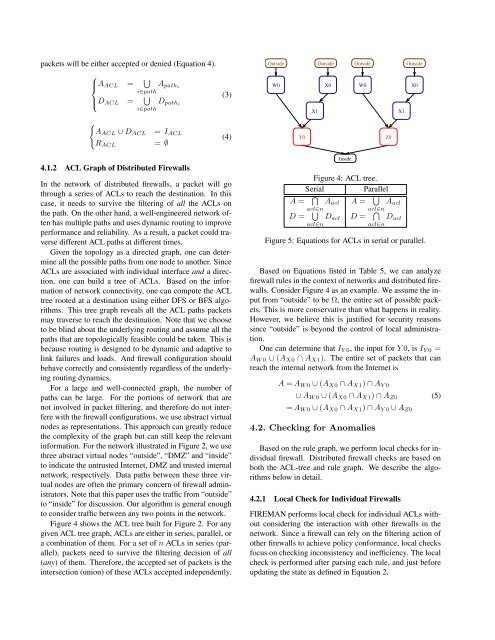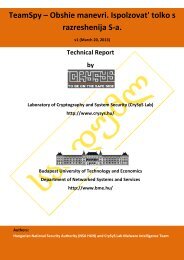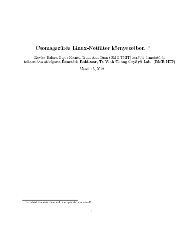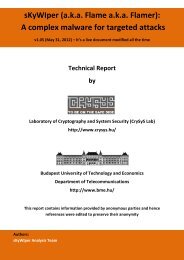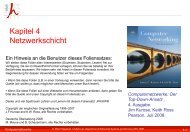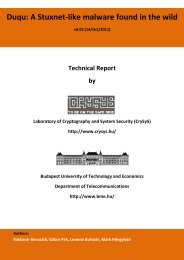FIREMAN: A Toolkit for FIREwall Modeling and ANalysis
FIREMAN: A Toolkit for FIREwall Modeling and ANalysis
FIREMAN: A Toolkit for FIREwall Modeling and ANalysis
You also want an ePaper? Increase the reach of your titles
YUMPU automatically turns print PDFs into web optimized ePapers that Google loves.
packets will be either accepted or denied (Equation 4).<br />
⎧<br />
⎪⎨ AACL =<br />
⎪⎩<br />
<br />
DACL = <br />
Apathi<br />
i∈path<br />
Dpathi<br />
i∈path<br />
<br />
AACL ∪ DACL = IACL<br />
= ∅<br />
RACL<br />
4.1.2 ACL Graph of Distributed Firewalls<br />
In the network of distributed firewalls, a packet will go<br />
through a series of ACLs to reach the destination. In this<br />
case, it needs to survive the filtering of all the ACLs on<br />
the path. On the other h<strong>and</strong>, a well-engineered network often<br />
has multiple paths <strong>and</strong> uses dynamic routing to improve<br />
per<strong>for</strong>mance <strong>and</strong> reliability. As a result, a packet could traverse<br />
different ACL paths at different times.<br />
Given the topology as a directed graph, one can determine<br />
all the possible paths from one node to another. Since<br />
ACLs are associated with individual interface <strong>and</strong> a direction,<br />
one can build a tree of ACLs. Based on the in<strong>for</strong>mation<br />
of network connectivity, one can compute the ACL<br />
tree rooted at a destination using either DFS or BFS algorithms.<br />
This tree graph reveals all the ACL paths packets<br />
may traverse to reach the destination. Note that we choose<br />
to be blind about the underlying routing <strong>and</strong> assume all the<br />
paths that are topologically feasible could be taken. This is<br />
because routing is designed to be dynamic <strong>and</strong> adaptive to<br />
link failures <strong>and</strong> loads. And firewall configuration should<br />
behave correctly <strong>and</strong> consistently regardless of the underlying<br />
routing dynamics.<br />
For a large <strong>and</strong> well-connected graph, the number of<br />
paths can be large. For the portions of network that are<br />
not involved in packet filtering, <strong>and</strong> there<strong>for</strong>e do not interfere<br />
with the firewall configurations, we use abstract virtual<br />
nodes as representations. This approach can greatly reduce<br />
the complexity of the graph but can still keep the relevant<br />
in<strong>for</strong>mation. For the network illustrated in Figure 2, we use<br />
three abstract virtual nodes “outside”, “DMZ” <strong>and</strong> “inside”<br />
to indicate the untrusted Internet, DMZ <strong>and</strong> trusted internal<br />
network, respectively. Data paths between these three virtual<br />
nodes are often the primary concern of firewall administrators.<br />
Note that this paper uses the traffic from “outside”<br />
to “inside” <strong>for</strong> discussion. Our algorithm is general enough<br />
to consider traffic between any two points in the network.<br />
Figure 4 shows the ACL tree built <strong>for</strong> Figure 2. For any<br />
given ACL tree graph, ACLs are either in series, parallel, or<br />
a combination of them. For a set of n ACLs in series (parallel),<br />
packets need to survive the filtering decision of all<br />
(any) of them. There<strong>for</strong>e, the accepted set of packets is the<br />
intersection (union) of these ACLs accepted independently.<br />
(3)<br />
(4)<br />
Outside Outside Outside<br />
Outside<br />
W0 X0<br />
W0<br />
Y0<br />
X1<br />
Inside<br />
Z0<br />
Figure 4: ACL tree.<br />
Serial Parallel<br />
A = <br />
Aacl A =<br />
acl∈n<br />
<br />
acl∈n<br />
D = <br />
Dacl D = <br />
acl∈n<br />
Aacl<br />
X1<br />
Dacl<br />
acl∈n<br />
Figure 5: Equations <strong>for</strong> ACLs in serial or parallel.<br />
Based on Equations listed in Table 5, we can analyze<br />
firewall rules in the context of networks <strong>and</strong> distributed firewalls.<br />
Consider Figure 4 as an example. We assume the input<br />
from “outside” to be Ω, the entire set of possible packets.<br />
This is more conservative than what happens in reality.<br />
However, we believe this is justified <strong>for</strong> security reasons<br />
since “outside” is beyond the control of local administration.<br />
One can determine that IY 0, the input <strong>for</strong> Y 0, is IY 0 =<br />
AW 0 ∪ (AX0 ∩ AX1). The entire set of packets that can<br />
reach the internal network from the Internet is<br />
A = AW 0 ∪ (AX0 ∩ AX1) ∩ AY 0<br />
∪ AW 0 ∪ (AX0 ∩ AX1) ∩ AZ0<br />
= AW 0 ∪ (AX0 ∩ AX1) ∩ AY 0 ∪ AZ0<br />
4.2. Checking <strong>for</strong> Anomalies<br />
Based on the rule graph, we per<strong>for</strong>m local checks <strong>for</strong> individual<br />
firewall. Distributed firewall checks are based on<br />
both the ACL-tree <strong>and</strong> rule graph. We describe the algorithms<br />
below in detail.<br />
4.2.1 Local Check <strong>for</strong> Individual Firewalls<br />
<strong>FIREMAN</strong> per<strong>for</strong>ms local check <strong>for</strong> individual ACLs without<br />
considering the interaction with other firewalls in the<br />
network. Since a firewall can rely on the filtering action of<br />
other firewalls to achieve policy con<strong>for</strong>mance, local checks<br />
focus on checking inconsistency <strong>and</strong> inefficiency. The local<br />
check is per<strong>for</strong>med after parsing each rule, <strong>and</strong> just be<strong>for</strong>e<br />
updating the state as defined in Equation 2.<br />
X0<br />
(5)


